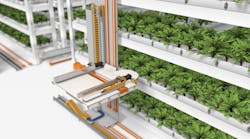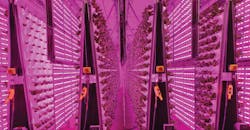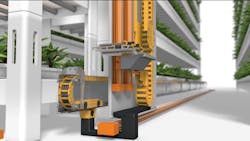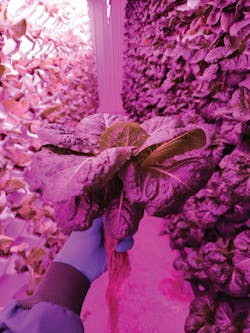Living Greens Farm is not your grandfather’s farm. There are no acres to harvest, tractors to fuel and repair, or wagons to haul. The Minnesota business produces an assortment of fresh greens from an indoor farm with environmentally-friendly measures such as less water, less shipping, and fewer herbicides.
And less land. A lot less.
Living Greens Farm is one business joining in the worldwide emergence of vertical farming. In about 4,000 square yards—the equivalent of one acre—the business extracts the same quantity of food produced on about 100 acres of conventional agriculture.
With the world population rapidly expanding and the land required for farming rapidly diminishing, vertical farming is expected to grow significantly over the next few years. Business Wire reported vertical farming values in the United States are expected to reach $3 billion by 2024, growing at a compound annual growth rate of 24% through 2024.
“We whole-heartedly believe indoor/vertical farming is the path forward for agriculture,” said Nate Klingler, Vice President of Business Development for Living Greens Farm. “Demand for food is growing, and demand for safe, delicious, and healthy food is growing at an even faster rate.”
Another factor is playing into the growth of vertical farming: automation. The growth of the industry coincides perfectly with the advent of sophisticated machinery that allows many farming tasks to be completed with automation. In 2018, an Ohio business broke ground to become the nation’s first fully-automated vertical farm.
“The majority of vertical farming systems have some kind of automation built into them so they can operate 24/7,” said Charles Jaskolka of igus, whose company’s products are included in a traverse system at Living Greens Farms. “Plants need constant attention and these facilities provide consistent environmental conditions that optimize growing conditions.”
How They Do It
Each vertical farm develops its own science and mechanical equipment for producing crops. Living Greens Farm uses a patented Air Grown vertical system that dramatically reduces the need for land, energy, water, and space.
Plant roots remain in the air 99.9% of the time, the company reports, and thrive when spritzed with nutrient-rich mist. No soil is needed. “That opens up a lot of possibilities, including the fact that frozen ground during winter is no longer an obstacle,” the company says on its website.
The result is healthy crops that thrive under the perfect balance of light, air, humidity, and nutrition. Its products are among the safest and healthiest offered to consumers. Its products require 95% less water and shipping, and 99% less land. Residents in the Midwest can purchase products at Whole Foods, Walmart, and many other grocery stores.
The most critical component to Living Greens’ method is a patented traveling carriage system. The system allows the plants to receive a consistent supply of nutrient-rich water. Living Greens received a patent in 2016 for its irrigation system. The system developed over more than a decade of research and development. The irrigation is controlled via custom-developed software that controls all aspects of the farm. Everything from temperature and humidity, to wind speeds, light levels, and water amounts.
“Living Greens Farm was a science and engineering operation for many years while we worked to make our proprietary aeroponic grow systems commercially viable,” Klingler said. “There were many challenges along the way. Many different versions of the systems were developed, tried, scrapped, or refined. That went on for years.”
Traveling Carriage Irrigation
The traverse system used by Living Greens includes a 16-ft energy chain manufactured by igus, the Germany-based manufacturer of motion plastics. The company runs its North American operations out of Providence, R.I.
The H4-32 energy chain from igus is frequently used in applications that require high speeds and/or accelerations, quiet operation, and long travels. It is also used in applications where high fill weights are needed, such as the case with Living Greens.
A water line is set into the energy chain, and the system runs 24 hours a day and 7 days a week throughout the year. Living Greens has 74 traverse systems in place at its Minnesota location, and 12 more at a sister farm. Klingler said the company is also working to license its technology to people interested in starting their own farms in Europe, Asia, and Africa. Each energy chain disperses 130,000 gallons of water each day, about 5,417 gallons per hour.
“It’s important that our plants have a consistent supply of water, and this carriage system is the delivery method for supplying that water,” Klingler said.
Protecting the water line
Jaskolka said the energy chain acts as a guide to keep the water line in place so that it does not wander or get caught in the structure. “The benefit of an automated system is that it allows for better coverage when watering the plants,” Jaskolka said. “It also doesn’t over saturate the plants because they get a dousing of water briefly and the water has a chance to soak in before they get their next drink.”
Klingler said developing the traverse system was one of the challenges in the company’s development. “We were working in a very small space,” he said. “The carriage needs to travel a relatively lengthy distance with a heavy water line. The main feature that we liked about the igus energy chain was that we could incorporate water hose protection. Water is very important to our operation so protecting that source during delivery was essential.”
Energy chains from igus are used in a wide range of applications. The dry-running chains require little maintenance and resist dirt and debris. Engineered composite plastic materials from igus are designed with base materials, fibrous reinforcements, and solid lubricants that eliminate the need for external lubrication.
Water Treatment
Klingler said the water comes from the city of Faribault. The water is completely distilled and then treated to provide what the plants need to thrive in a “spa-like” environment.
“We use inorganic salts to enrich our water. Using inorganic salts allows our growers the ability to choose the individual components the plants need to survive and thrive,” Klingler said. “Inorganic salts also enable the plants to be able to obtain the nutrients they need in the specific ionic form they prefer. Organic nutrients tend to be in a more basic form and the plant then has to expend energy to convert the organic nutrients into the form they need.”
“Our products are grown indoors in exceptionally sanitary conditions away from all dangers that can cause foodborne illness,” the company says. “No birds, canal water, insects, animals or the like are allowed in. The result? Beautiful, safe, and delicious salads.”
Rapidly Growing Industry
Living Greens Farm is not the only vertical farming business in the United States. There are plenty more, and the industry is growing in other nations, too. Japan has more than 150 vertical farming businesses with artificial lights. A business in Germany has partnered with Kroger, a leading U.S. grocery store, to offer vertical farming units that can be installed in-store and inside restaurants. In Singapore, where 90% of its food is imported from over 30 countries, the nation’s first vertical farm opened last year.
Besides demand, vertical farming is expanding because it can reach consumers quickly. By 2050, according to the U.S. Department of Agriculture, 66% of the population is expecting to be living in urban areas. “Producing fresh greens and vegetables close to these growing urban populations could help meet growing global food demands in an environmentally responsible and sustainable way by reducing distribution chains to offer lower emissions, providing higher-nutrient produce, and drastically reducing water usage and runoff,” the USDA wrote.
With its technology in place, Living Greens Farm is ahead of many others in an embryonic global business that is rapidly evolving. Living Greens Farm might not be your grandfather’s farm, but the food tastes just as good, less manual labor is required, and crops are not ruined by weather whims. The time is right for a new way to generate food in an environmentally friendly way.
“With dwindling amounts of land that can be used for farming, as well as the decreasing amount of clean water available for farming it just makes sense,” Klingler said. “Living Greens Farm plans to play a big part in this path forward and is excited to see what the future holds.”














